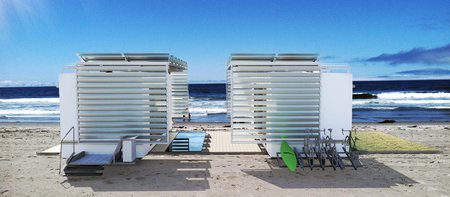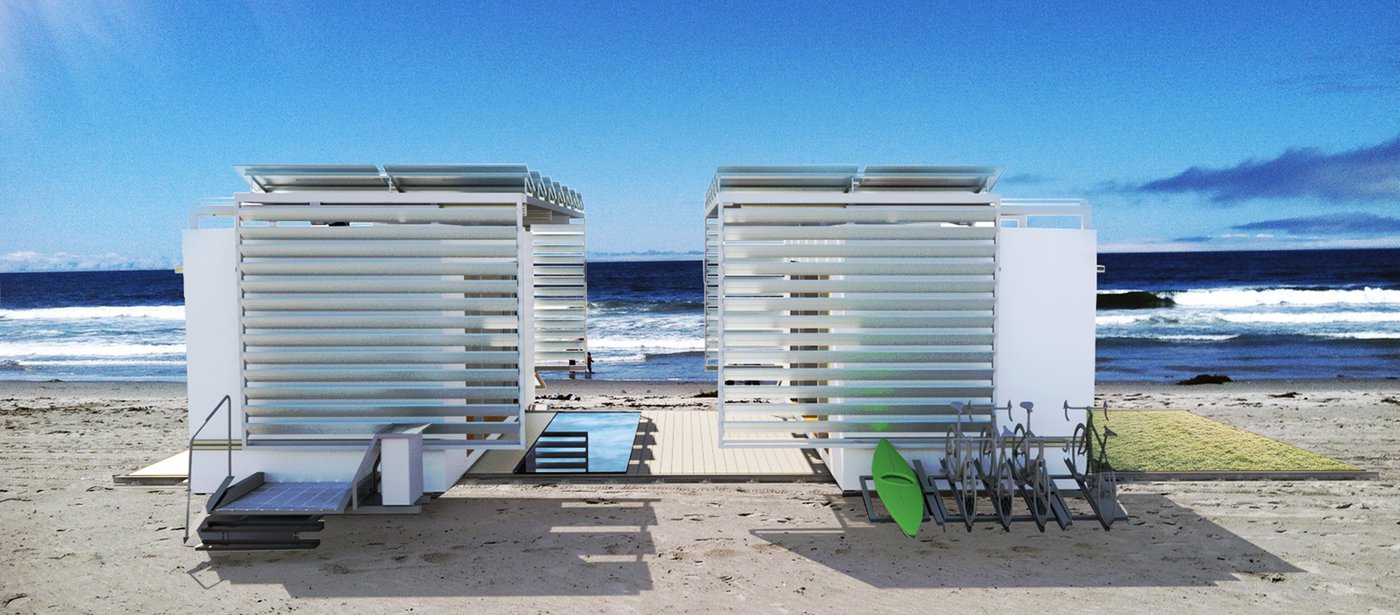DALE is nearly ready to face the judges. The Dynamic Augmented Living Environment, Caltech's collaboration with the Southern California Institute of Architecture (SCI-Arc) is now on-site at the Department of Energy's 2013 Solar Decathlon competition site in Irvine, California.
The SCI-Arc/Caltech team has been planning DALE, its unique and completely solar-powered home, since its competition proposal was accepted in January 2012, along with proposals from 19 other American and international teams. Nearly 40 Caltech students participated in the design process, most of which took place in an engineering project course called Introduction to Multidisciplinary Systems Engineering, and offered during the 2012-2013 academic year. Of the students in this course, taught by Melany Hunt, Dotty and Dick Hayman Professor of Mechanical Engineering and a vice provost, seven stayed on, spending their summer actually building the sustainable house.
Once the majority of construction was complete in late September, the SCI-Arc/Caltech team had to pack up DALE and physically move the entire house from its construction site on the SCI-Arc campus in downtown Los Angeles more than 40 miles south to Orange County Great Park in Irvine, where this year's competition will be held starting on October 3.
While some of DALE's competitors had to employ the use of large cranes to transport their entries or coordinate weeks-long international transportation to the competition site, project manager Andrew Gong (BS '12) says that DALE only spent about three-and-a-half hours in transit. "We picked up DALE with a heavy-duty forklift and placed it on long trucks," Gong says. "And there wasn't any damage other than expected small scrapes to the bottom from the forks."
DALE's design consists of two configurable, box-like modules—one kitchen and bathroom module, and one living and sleeping space module—that can move together or apart. When in the open configuration, DALE's design exploits the ambient outdoor temperature to heat or cool the house, helping to maintain a comfortable temperature within the house without using extra energy for heating and air-conditioning. This moving house was designed with sustainability in mind, but the modules also made it easier for team DALE to truck its house down the interstate to Irvine. "Since the house is composed of modules, it was actually fairly simple to pack up and ship. The main issue was just making sure everything got packed on time," Gong says.
The SCI-Arc/Caltech collaboration is one of 20 teams in the Department of Energy competition, each challenged to design and build affordable, attractive, energy-efficient houses that have the comforts of modern living but are powered only by the sun. As the name "Solar Decathlon" implies, teams will compete for the best total number of points in 10 contests. A panel of experts will use the contests to judge and score the entries based on features ranging from architecture and market appeal to affordability and each house's ability to host a movie night—called the Home Entertainment Contest.
The SCI-Arc/Caltech team wants DALE to score well in the overall competition, but the Caltech team members hope they score especially well in one particular aspect: the Engineering Contest. In this contest, a jury made up of professional engineers will judge each house based on the home's functionality, efficiency, innovation, reliability, and project documentation. "In 2011, with CHIP—our first Solar Decathlon entry—we came in second place. With DALE, we took that second place as a challenge," says Gong, "because now we have to get first, obviously!"
To optimize DALE's energy efficiency, the Caltech members of the team spent months calculating and modeling the home's likely energy usage during the competition. Thirty years of Orange County weather data were used to predict heating and air-conditioning needs for the October competition. "The contests are held on different days of the competition, and we based the energy budget on the contests we will have on a given day: the cooking contest, movie night, heating and air-conditioning test, etc.," Gong says. "With our competition energy budget, we then modeled out the performance required from the solar panels to meet that energy demand," Gong says.
According to their calculations, DALE's oversized solar panels will allow the house to be net-zero during the decathlon—meaning it will produce as much energy as it consumes. And in the future, if the house was used in the longer daylight hours of summer, DALE could produce far more energy than it uses, Gong adds.
The SCI-Arc/Caltech team also designed an energy-saving mobile app for DALE that would allow its owner to monitor the home's real-time energy supply and consumption and take steps to use less energy. "As a team, we are aiming to create a house that is not only energy efficient by itself, but also encourages the inhabitants to live a greener lifestyle," Caltech electrical engineering student Do Hee Kim says on the DALE website. "We have made it simple for homeowners to execute these actions by having the ability to remotely turn on and off home appliances," Kim says.
Visitors will be able to interact with DALE and explore its innovative features during public viewings scheduled for October 3–6 and 10–13 from 11 a.m. to 7 p.m. In addition, visitors arriving at 2:30 will get to see the home reconfigured in real time, a feature that sets DALE apart from the other Solar Decathlon entries. The winners will be announced on October 12, and just a few days later, the team will pack up for the move back to Los Angeles. After the competition, DALE will be displayed at the SCI-Arc campus.
And for any house hunters visiting the competition, the SCI-Arc/Caltech team has good news: DALE is for sale and can be delivered to a new owner. Although the Department of Energy provides a limited amount of seed money for Solar Decathlon teams, fundraising is necessary to cover the actual costs of production; funds from the sale of the home will go to recoup some this year's competition costs and could also help support an entry bid for the 2015 Solar Decathlon.
 An artist's rendering of DALE, the SCI-Arc/Caltech collaborative entry in the 2013 Department of Energy Solar Decathlon competition.
Credit: SCI-Arc/Caltech
An artist's rendering of DALE, the SCI-Arc/Caltech collaborative entry in the 2013 Department of Energy Solar Decathlon competition.
Credit: SCI-Arc/Caltech

